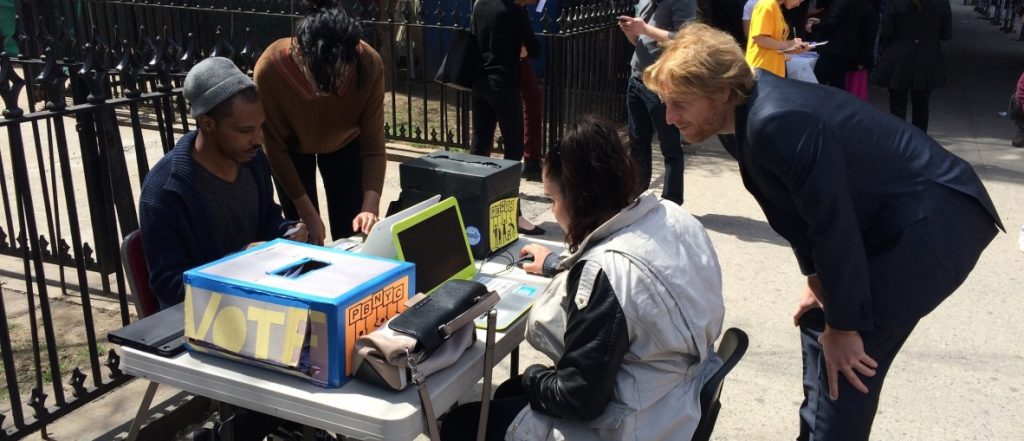CAUCUSTOCRACY
- MICAH L. SIFRY
- February 1, 2016
- 3:50 pm
Breaking down the Clinton-Sanders battle for the nomination; an oral history of Howard Dean’s YEAHHHHHHHH; and more.
Iowa watch: Joe Rospars, the founder and CEO of Blue State Digital, draws on his seminal experience in digital campaigning for Howard Dean and Barack Obama to produce a very smart analysis in the Washington Post of the dynamics of the Clinton-Sanders presidential battle. Rospars points out that both candidates’ teams “inherited an ingrained culture of constant testing and data-driven optimization that shapes every ad, every email, every call script for a volunteer and every list of voters they call. And both campaigns have built their organizing efforts on the foundation of tech and data infrastructure at the Democratic National Committee that first came together in the 2008 cycle.”
Rospars, who is neutral in the 2016 primary, also notes that “whether you support him or not, Sanders’s campaign is the home of the prevailing grass-roots energy in this race. The most recent financial reports, for the period that ended in October, showed that the amount Clinton raised from donors giving less than $200 decreased from $8 million to $5.2 million, while Sanders’s low-dollar take nearly doubled, from $10.4 million to $20.2 million. Clinton raised barely a quarter of the amount from grass-roots donors that Sanders did. Whatever the ultimate result, that shows the Sanders campaign has accomplished extraordinary things in volunteer mobilization and small-donor fundraising, period.” The Sanders campaign announced that it will bring in $20 million in January, Matea Gold reports for the Washington Post, calling it “an astonishing sum that underscores the power of its online fundraising operation.”
While you wait for the Iowa caucus results, you can take a trip down memory lane with Esquire’s Jack Holmes, who has gathered an oral history of “YEAHHHHHHH!” from a gaggle of former Howard Dean campaign staffers. Relive how internet-powered Howard melted down, with the infamous scream just the crowning blow.
Caucus math: Sasha Issenberg reports for Bloomberg Politics on how the Hillary Clinton campaign has worked hard to avoid the mistakes it made in the lead-up to Iowa in 2008, when Barack Obama’s superior field operation took her by surprise. From what Issenberg details, the Clinton team has a “customized campaign plan for each” of the state’s 1,681 precincts.
Republican Ted Cruz’s campaign is reportedly doing a lot of behavioral targeting, but a mailer sent to some Iowans warning them that they had a “failing” voting “score” was denounced by Iowa’s secretary of state, who says “There is no such thing as an election violation related to frequency of voting, reports Mother Jones’ Pema Levy. Hilariously, one of the people who received a Cruz mailer was Iowa State University professor David Peterson, who runs the journal Political Behavior, and who told Levy that his own alleged voting score was inaccurate. (Every one of his neighbors who received the same mailer got the same score.)
Echelon Insights Patrick Ruffini (longtime friend of Personal Democracy Media) has a great list of things to watch for those of you politics junkies who want to be the smartest people in the room as tonight’s Iowa results come in.
Thinking ahead: Some guy named Sifry explains for The National Memo why Mike Bloomberg is probably going to (again) not run for President as a third-party candidate.
Crypto-wars, continued: Privacy and technology expert Ashkan Soltani has left the White House Office of Science and Technology Policy because he was denied a security clearance, The Guardian’s Danny Yadron reports. Soltani had previously worked for the Federal Trade Commission, but he had also done work for the Washington Post, helping it analyze and protect its cache of NSA documents leaked by Edward Snowden.
President Obama wants to dedicate $4 billion in new Department of Education funding over the next three years to reward states for increasing computer science education in schools, Davey Alba reports for Wired.
This is civic tech: Voqal has announced its 2016 fellows and they include several building tools that have civic tech written all over them: for example, Marquis Cabrera’s RateMyFosterHome.com aims to help social workers improve the foster-care process; and Andrea Hart’s community data project creates a pipeline for south and west Chicago residents to create new data sets to help civic investigations.
On Friday, Facebook announced that it will ban the private sale of guns, Vindu Goel and Mike Isaac reported for the New York Times. Licensed dealers and clubs can still maintain Facebook pages. The company will be relying on user reports, and says it will remove any post that violates the new policy.
Cara Giamo reports for Atlas Obscura on a group of MIT-based activists who are working to address Wikipedia’s well-documents bias toward white male editors (and content).
If you are hoping to speak at the second annual TIC-TeC (The Impacts of Civic Technology Conference) in Barcelona this April, you’d best get your proposal in by this Friday. (We got ours in already—nyah, nyah!)
Change.org is looking to hire an executive director for its newly formed Change.org Charitable Foundation.


